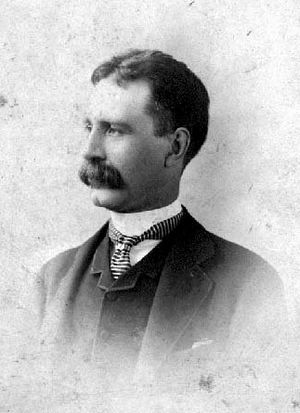Andrew Onderdonk facts for kids
Andrew Onderdonk (born August 30, 1848 – died June 21, 1905) was an American construction expert. He built many big projects in the western parts of North America. These included the San Francisco seawall in California and parts of the Canadian Pacific Railway in British Columbia.
Andrew Onderdonk was born in New York City. His family had Dutch roots. He studied at the Rensselaer Polytechnic Institute. Later, he married Sarah Delia Hilman. He started his career by planning towns and roads in New Jersey. Then, he moved west. He worked for a wealthy businessman named Darius Ogden Mills on large building projects. Andrew Onderdonk passed away in Oscawana-on-the Hudson, New York.
Contents
Building the San Francisco Seawall
Andrew Onderdonk's first major project was the San Francisco seawall. This big job took three years to finish. It involved building special docks for ferry boats and strong walls along the San Francisco Harbor. These walls helped protect the city's waterfront. His son, Andrew Jr., was born in San Francisco during this time.
Constructing the Canadian Pacific Railway
In 1879, Onderdonk won several important contracts. These contracts were to build the western part of the Canadian Pacific Railway. This railway was very important for connecting Canada from east to west.
He worked directly for the Government of Canada. He built a 227-mile (365 km) section of the railway. This part went from Port Moody, near Vancouver, northeast to Savona (close to Kamloops). After finishing these sections, he continued building eastward. He worked under a new contract with the Canadian Pacific Railway company. His work stopped in Eagle Pass in 1885 when he ran out of railway tracks.
Onderdonk and his wife moved to Yale, British Columbia. This allowed him to be close to the construction work. Yale was a key spot because steamships could travel there on the Fraser River. This made it easy to get supplies. The section between Yale and Port Moody was especially challenging to build.
Chinese Workers on the Railway
One important part of Onderdonk's work in British Columbia was his use of Chinese workers. The railway had to go through the Fraser Canyon. This area had huge cliffs that needed a lot of expensive tunneling. Onderdonk got permission from the Canadian government to bring in Chinese workers. They came from California and China.
Many people in British Columbia, including the government, did not like this idea. They wanted to hire British railway workers. But the Canadian government wanted to save money. Chinese workers could be hired for less pay. White workers worried about losing their jobs or having their wages lowered. This was because employers sometimes paid Chinese immigrants less.
Onderdonk told the Canadian government that the railway could not be built without Chinese workers. So, the government and people of British Columbia agreed. They wanted the railway finished to connect to eastern markets.
Historians believe Onderdonk brought in thousands of Chinese workers. They were often given the most dangerous jobs. This included blasting tunnels with nitroglycerin, which is a very unstable explosive. Many Chinese workers died in accidents. Others died from scurvy during the winter. Scurvy is a disease caused by not getting enough vitamins. The workers often ate mostly rice and had little money for other foods. Unlike white workers, injured Chinese workers did not get care at the company hospital. Their fellow workers had to help them.
When the construction ended, many Chinese workers were left stranded. They had no food or water. White charities in Vancouver later helped them get tickets to go back to China or California.
Sometimes, there were fights between Chinese and white workers. But generally, managers thought the Chinese workers were efficient and hard-working. However, many thousands of them left to search for gold. They preferred gold mining over the tough conditions of the railway camps.
Canadian Pacific Contracts Completed
After finishing the government contracts, Onderdonk took on new contracts directly with the Canadian Pacific Railway. He built tracks eastward to meet the railway coming from Eastern Canada. His section ended at Craigellachie, BC.
The section east of Savona was easier to build than the Fraser Canyon part. The railway followed the south shore of Kamloops Lake, went through Kamloops, and then along the South Thompson River and Shuswap Lake. Steamboats on these rivers helped bring building materials.
In the summer of 1885, Onderdonk's workers ran out of rail at a place later called Craigellachie. The railway coming from the east reached this spot in November. The very last spike of the Canadian Pacific Railway was hammered in on November 7, 1885.
Other Important Work
After his work on the Canadian Pacific Railway, Onderdonk continued to get more contracts. He built railways and canals, mostly in eastern Canada and the United States. In 1895, he got a contract from the Canadian government. This was to build parts of the Trent–Severn Waterway in Ontario.
In 1899, he tried to get a contract to build the first part of the New York City Subway. He didn't get that job. However, he did win a contract to remove rock and dirt from a tunnel under the Hudson River. He used this removed material to make Governor's Island bigger.
Legacy
- Mount Onderdonk in British Columbia was named after him. It is in the northern Selkirk Mountains.
- A railway station on the Canadian Pacific Railway is named "Onderdonk." It is located at MP 107.5 (Pitt Meadows BC).
Images for kids



